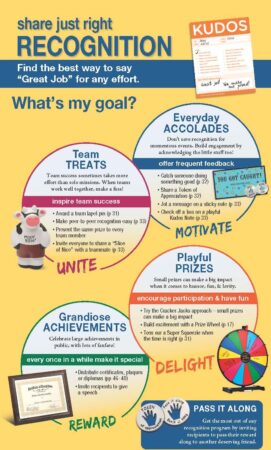Recognition increases performance 24%
Always on the lookout for new research about the correlation of workplace appreciation with job satisfaction and performance, I was happy to stumble across the latest research study by Canva. I wanted to find out just how much recognition and reward affect workers’ performance. Following are some of the highlights of the Canva Study and other citations noting the importance of creating a culture of appreciation at work:
Appreciation correlates with “loving my job”
In a recent study by Canva, research showed that 94% of employees who feel highly appreciated love their workplace and 91% love their job. By contrast, of the 18% of employees who reported feeling “unappreciated” or “neutral” about their workplace, only 33% expressed love for their job. An organizational culture of appreciation also correlates with employee satisfaction. 81% of the “very satisfied” employees said their company fosters a culture of appreciation.
Recognition improved performance by as much as 24%
A large number of studies over the years have verified that recognition is indeed a powerful reinforcer of employee behaviors leading to performance improvement. A Meta-analysis of 19 reinforcement theory studies revealed an average effect of recognition on performance improvement of 15% (Stajkovic and Luthans, 1997 ).
This was followed by a more comprehensive meta-analysis that examined 72 reinforcement theory studies in organizational settings that found an average effect size of social recognition on performance of 17% (Stajkovic and Luthans, 2003 ). Finally, in a recent field experiment, informal recognition increased performance of workers in the manufacturing setting by 24% (Stajkovic and Luthans, 2001 ). …
A nationwide survey of US workers found that about 70% report that non-monetary forms of recognition provide the best motivation ( HR Focus, 1999). This same survey found that employees favor recognition from managers and supervisors by a margin of almost 2:1 over recognition from co-workers or other sources. (Nelson, 1994).
Fred Luthans and Alexander D. Stajkovic, “Provide Recognition for Performance Improvement.”
Progress, Catalysts, Nourishers
In a May 2011 article in the Harvard Business Review, Teresa Amabile and Steven Kramer explain how to “truly engage your workers.” They suggest:
“Help them see their own progress.” Workers’ diaries in a number of jobs show that good days are characterized by three things: progress, “catalysts”, and “nourishers”, and bad days are marked by the opposite: setbacks, inhibitors, and toxins.
Thanks to Kim Marshall and the Marshall Memo, for his brief synopsis of this great article. “The Power of Small Wins” by Teresa Amabile and Steven Kramer in Harvard Business Review, May 2011 (Vol.89, #5, p. 70-80), no e-link available; the authors can be reached at [email protected] and [email protected].
So what types of non-monetary rewards are the most effective?
Bob Nelson, author of 1001 Ways to Energize Employees reports research indicating that the type of recognition employees appreciate most is recognition for their work. In fact, 78% of employees indicated that recognition by managers for good work was “very” or “extremely” important (Nelson 2004). The number one choice for recognition is sincere praise given promptly with specific examples.



Definitely not too basic. I like your perspective!